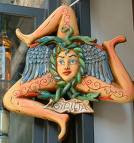
On May 28 in Aberdeen, we embark the Aleksey Maryshev, a comfortable and modern research vessel. She belongs to the Hydro-graphic Institute in St. Petersburg and was built in Finland in 1990. She was designed as an ice-strengthened vessel and converted in the Netherlands for passenger use, making her ideally suited for expedition cruising. The vessel is 66 metres (210 feet) long, with a breadth of 12.8 metres (42 feet), a draft of approximately 3.5 metres (12 feet) and a displacement of 2000 tons. She has two powerful engines that allow a speed of up to 14 knots. The Aleksey Maryshev has a capacity of 46 passengers in cabins with outside views.
We voyage this week with Victor Emanuel Nature Tours of Austin through Scotland's frigid northern waters, mixing ship travel, lectures, shore excursions and Zodiac expeditions. We do not want to fall in these waters nor do we wish for the rough seas one so often experiences here. We sail north to Shetland where we explore the eerie, nocturnal world of European Storm-Petrels at their colony, nesting in a fine Iron Age broch, and we discover the strong Viking and Norse influences in these northerly outposts. We stroll around the large complex of Jarlshof, occupied since the Bronze Age. Passing many spectacular seabird colonies, we spend a morning on the lonely Fair Isle, halfway between Shetland and Orkney—famous for its distinctive knitting designs and long-established Bird Observatory.
The Orkneys have some of the best-preserved archaeological sites in Europe: Maes Howe, the most complete Neolithic tomb in existence; the Ring of Brodgar, the largest Stone Circle in Scotland; and Skara Brae, a finely excavated Neolithic village. Here, too, are more "recent" delights, such as the fine town of Kirkwall itself with its early Norse-influenced cathedral and the World War II battleships of the Churchill Barriers. We sail past 1,000-foot sea cliffs and Pinnacles of Hoy, where breeding seabirds—including Great Skuas—darken the skies, as we continue on to the Outer Hebridean islands of Harris and Lewis. Here we find more rugged scenery and remarkable ancient historical sites, such as the mysterious Standing Stones of Callanish. We discover what life was like just a few centuries past in the rebuilt villages of blackhouses, the traditional low dwelling places of the Gaelic peoples in the 16th-19th centuries.
A highlight of our trip is faraway St. Kilda archipelago, abandoned as Britain's remotest inhabited outpost in 1930. Here is a land of superlatives: the largest Northern Gannet colony in the world, the largest Northern Fulmar colony in Europe, and the highest sea cliffs in Britain at 1,400 feet.
Heading back east we arrive at gentler islands of the Inner Hebrides with further great birding opportunities—many northern specialties, breeding shorebirds, loons, and wildfowl—to keep us busy. Throughout our sea voyage we will have seabirds around us constantly (the British Isles are home to globally important numbers of all the North Atlantic species, including Manx Shearwater). The pretty and varied Island of Mull and offshore satellites beckon. Canna and Mull are strongholds of nesting White-tailed Eagles. Staffa, with its columnar basalt cliffs and Fingal's Cave, was an inspiration for Mendelssohn's Hebrides Overture. We visit Iona and its Abbey, where Corn Crakes rasp their loud interminable songs in rich flower meadows that have remained the same since the island first became a site of early Christian settlement and pilgrimage by St. Columba 1,400 years ago. Our sea voyage finishes on May 4th on the other side of Scotland, in the west coast port of Oban--hopefully dry and reasonably warm.
Heading back east we arrive at gentler islands of the Inner Hebrides with further great birding opportunities—many northern specialties, breeding shorebirds, loons, and wildfowl—to keep us busy. Throughout our sea voyage we will have seabirds around us constantly (the British Isles are home to globally important numbers of all the North Atlantic species, including Manx Shearwater). The pretty and varied Island of Mull and offshore satellites beckon. Canna and Mull are strongholds of nesting White-tailed Eagles. Staffa, with its columnar basalt cliffs and Fingal's Cave, was an inspiration for Mendelssohn's Hebrides Overture. We visit Iona and its Abbey, where Corn Crakes rasp their loud interminable songs in rich flower meadows that have remained the same since the island first became a site of early Christian settlement and pilgrimage by St. Columba 1,400 years ago. Our sea voyage finishes on May 4th on the other side of Scotland, in the west coast port of Oban--hopefully dry and reasonably warm.














 Strait of Messina channel: c.20 mi (32 km) long and from 2 to 10 mi (3.2-16 km) wide, separating the Italian peninsula from Sicily and connecting the Ionian and Tyrrhenian seas. Reggio di Calabria, in SW Italy, and Messina, in NE Sicily, are the main ports. A ferry crosses the dangerous waters of the strait from Messina to Villa San Giovanni. The currents, whirlpools, and winds of the strait, which still hamper navigation, gave rise in ancient times to many legends about its dangers to navigators.
Strait of Messina channel: c.20 mi (32 km) long and from 2 to 10 mi (3.2-16 km) wide, separating the Italian peninsula from Sicily and connecting the Ionian and Tyrrhenian seas. Reggio di Calabria, in SW Italy, and Messina, in NE Sicily, are the main ports. A ferry crosses the dangerous waters of the strait from Messina to Villa San Giovanni. The currents, whirlpools, and winds of the strait, which still hamper navigation, gave rise in ancient times to many legends about its dangers to navigators.






